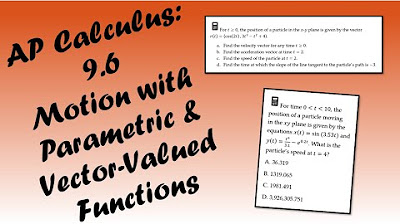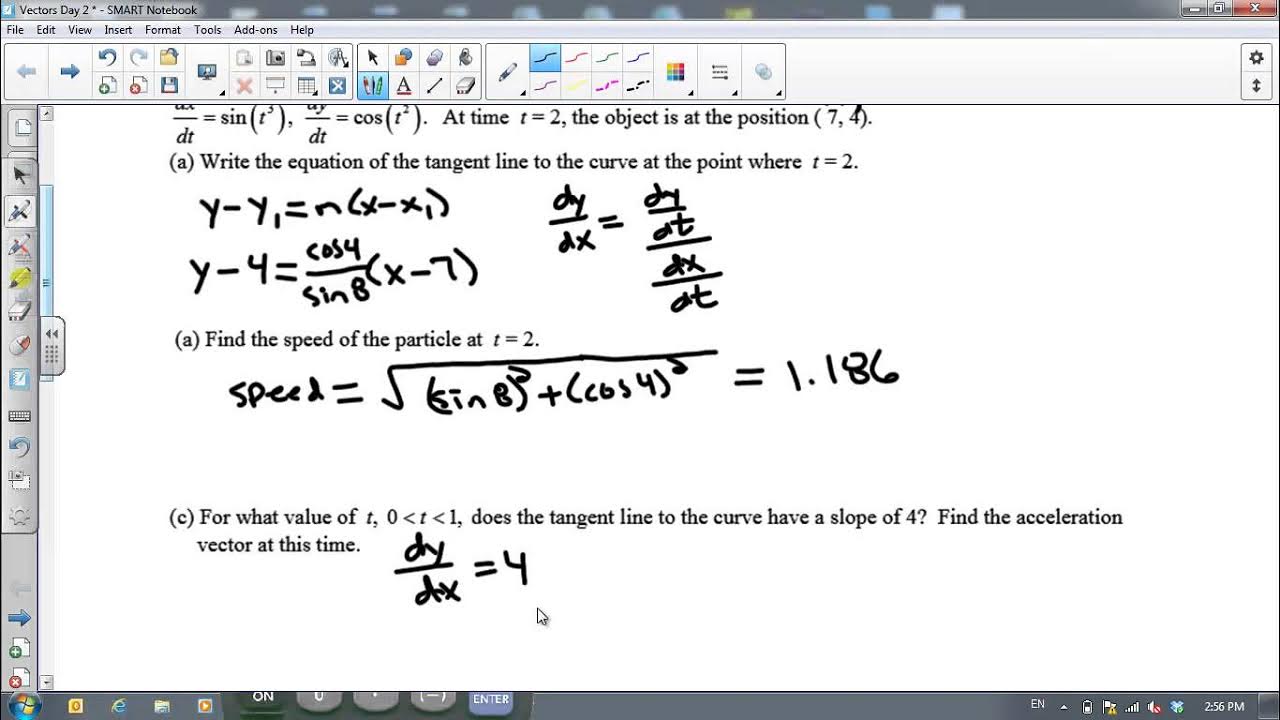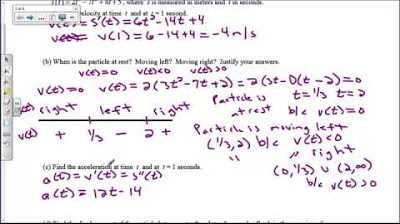Vectors- Motion along a curve, Day 1
TLDRThis educational video explores vectors in parametric motion, explaining how to derive position, velocity, and acceleration vectors. It covers finding the velocity and acceleration at a specific time, calculating vector magnitudes, and integrating velocity to find position. The script also discusses arc length and conditions for a particle being at rest.
Takeaways
- 📚 The lesson is about understanding vectors in the context of parametric motion, specifically focusing on position, velocity, and acceleration vectors.
- 🔍 The position vector is given as a function of time 'T', and it helps in determining the x and y coordinates of a particle in motion.
- 📈 Velocity vector is defined as the derivative of the position vector, representing the rate of change of position with respect to time.
- 🚀 The script demonstrates how to calculate the velocity vector when T equals 1 by differentiating the position vector equations and then substituting T with 1.
- ⏩ Acceleration vector is the derivative of the velocity vector or the second derivative of the position vector, indicating the rate of change of velocity.
- 🔢 The magnitude of a vector, which represents its length, is calculated using the Pythagorean theorem, applicable to position, velocity, and acceleration vectors.
- 📉 The script explains how to find the speed of an object by finding the magnitude of the velocity vector, which is essentially the speed formula.
- 📌 The concept of arc length or total distance traveled by a particle in parametric motion is introduced, which is calculated by integrating the speed over a given interval.
- 🧘 A particle is considered at rest when both its horizontal and vertical velocity components are zero, which is determined by setting the derivatives equal to zero and solving for T.
- 🔄 The process of finding the position vector from a given velocity vector involves integration and using initial conditions to solve for constants of integration.
- 📝 The script concludes with an example that ties together the concepts of position, velocity, and acceleration vectors, along with their magnitudes and applications in parametric equations.
Q & A
What is the position vector in parametric motion?
-The position vector in parametric motion is a vector that gives the x and y coordinates of a particle at any given time 't'. It is typically represented as a function of 't', for example, X(t) for the x-coordinate and Y(t) for the y-coordinate.
How is the velocity vector of a particle in parametric motion defined?
-The velocity vector is defined as the derivative of the position vector. It represents the rate of change of the position vector with respect to time and is given by the derivatives of the x and y coordinates with respect to time, often denoted as X'(t) and Y'(t).
What is the formula for the velocity vector when the position vector is given by X(t) = 2t^3 - 5t^2 and Y(t) = 8t^3 + 3t^2?
-The velocity vector is obtained by differentiating the position vector with respect to time. For X(t) = 2t^3 - 5t^2, the derivative X'(t) is 6t^2 - 10t. For Y(t) = 8t^3 + 3t^2, the derivative Y'(t) is 24t^2 + 6t. Thus, the velocity vector is V(t) = (6t^2 - 10t, 24t^2 + 6t).
How do you find the acceleration vector of a particle in parametric motion?
-The acceleration vector is the derivative of the velocity vector, which is also the second derivative of the position vector. It represents the rate of change of the velocity vector with respect to time.
What is the acceleration vector when the velocity vector is given by X'(t) = 6t^2 - 10t and Y'(t) = 24t^2 + 6t?
-To find the acceleration vector, differentiate the velocity vector components with respect to time. For X'(t) = 6t^2 - 10t, the second derivative is 12t - 10. For Y'(t) = 24t^2 + 6t, the second derivative is 48t + 6. Thus, the acceleration vector is A(t) = (12t - 10, 48t + 6).
What is the magnitude of a vector and how is it calculated?
-The magnitude of a vector, also known as its length, is calculated using the Pythagorean theorem. For a vector with components (x, y), the magnitude is given by the square root of (x^2 + y^2).
How do you find the speed of an object given its velocity vector?
-The speed of an object is the magnitude of its velocity vector. If the velocity vector is given by V(t) = (X'(t), Y'(t)), the speed is the square root of (X'(t)^2 + Y'(t)^2).
What is the concept of arc length in parametric motion?
-The arc length is the total distance traveled by a particle in parametric motion between two points. It is calculated by integrating the speed over the interval of motion.
How do you determine when a particle is at rest in parametric motion?
-A particle is at rest when its velocity vector is zero. This means both the horizontal and vertical components of the velocity vector must be equal to zero at the same time.
How can you find the position vector of a particle if you know its velocity vector?
-To find the position vector from the velocity vector, you need to integrate the velocity vector components with respect to time. This will give you the position vector components as functions of time.
What are the initial conditions used to determine the constants of integration when finding the position vector from the velocity vector?
-The initial conditions are the known values of the position vector components at a specific time, usually when t = 0. These values are used to solve for the constants of integration in the integrated velocity vector components.
Can you provide an example of finding the position vector when given the velocity vector V(t) = (3t^2 - 4t, 2t)?
-To find the position vector from the given velocity vector V(t) = (3t^2 - 4t, 2t), you would integrate each component with respect to time. The horizontal position component would be the integral of (3t^2 - 4t), and the vertical position component would be the integral of (2t), plus constants of integration determined by initial conditions.
Outlines
📚 Introduction to Vectors and Velocity
This paragraph introduces the concept of vectors in the context of parametric motion. The speaker explains how to determine the position vector and its x and y coordinates at any given time 'T'. The focus then shifts to finding the velocity vector, which is defined as the derivative of the position vector. Mathematical expressions for the x and y components of the velocity vector are derived from the given position vector equations. The paragraph concludes with the calculation of the velocity vector when T equals 1, showcasing the process of plugging in values to obtain the vector components.
🚀 Calculating Acceleration and Vector Magnitudes
The second paragraph delves into the calculation of the acceleration vector, which is the derivative of the velocity vector or the second derivative of the position vector. The speaker provides the formula for the acceleration vector in terms of 'T' and calculates its value when T equals 1. The concept of vector magnitudes is introduced using the Pythagorean theorem, explaining how to find the magnitude of position, velocity, and acceleration vectors. The paragraph includes an example of finding the magnitude of the velocity vector when T equals 3, emphasizing the process of applying the Pythagorean theorem to vector components.
🔍 Arc Length and Conditions for Particle Rest
This paragraph discusses the concept of arc length, the total distance traveled by a particle in parametric motion. The speaker explains how to calculate the arc length by integrating the speed, which is the magnitude of the velocity vector, between two points where the particle intersects the x-axis. The process involves finding the x-intercepts and using the derivatives of the position vector to obtain the velocity components. Additionally, the paragraph addresses the conditions for a particle to be at rest, which occurs when both the horizontal and vertical components of the velocity vector are zero. The speaker provides an example of finding the times when the particle is at rest by setting the velocity components equal to zero and solving for 'T'.
🧭 Integrating Velocity to Find Position
The final paragraph demonstrates how to integrate the velocity vector to find the position vector of a particle. The speaker integrates the given velocity components with respect to time 'T' to obtain the position components. Initial conditions are used to solve for the constants of integration, ensuring the position vector is accurate at the starting time 'T' equals 0. The paragraph concludes with the calculation of the position vector when T equals 1, providing the specific coordinates of the particle at that time.
Mindmap
Keywords
💡Vectors
💡Parametric Motion
💡Velocity Vector
💡Acceleration Vector
💡Magnitude of a Vector
💡Position Vector
💡Derivative
💡Arc Length
💡At Rest
💡Integration
Highlights
Introduction to vectors and parametric motion with an example of a particle's position vector.
Explanation of how to find the velocity vector as the derivative of the position vector.
Derivation of the x and y components of the velocity vector for a given time t.
Calculation of the velocity vector at a specific time (t=1).
Introduction to the acceleration vector as the second derivative of the position vector.
Derivation of the x and y components of the acceleration vector.
Calculation of the acceleration vector at a specific time (t=1).
Discussion on the magnitude of a vector using the Pythagorean theorem.
Explanation of how to find the speed of an object using the magnitude of the velocity vector.
Example of finding the magnitude of the velocity vector at a specific time (t=3).
Introduction to arc length and the formula for calculating the total distance traveled.
Method to find the time when a particle is at rest by setting velocity components to zero.
Example of finding the time when a particle is at rest by solving for t in the velocity equation.
Process of integrating the velocity vector to find the position vector.
Use of initial conditions to determine the constants of integration for the position vector.
Final example of calculating the position vector at a specific time (t=1) using the integrated velocity vector.
Conclusion summarizing the basic concepts of parametric equations and their applications.
Transcripts
Browse More Related Video
5.0 / 5 (0 votes)
Thanks for rating:





